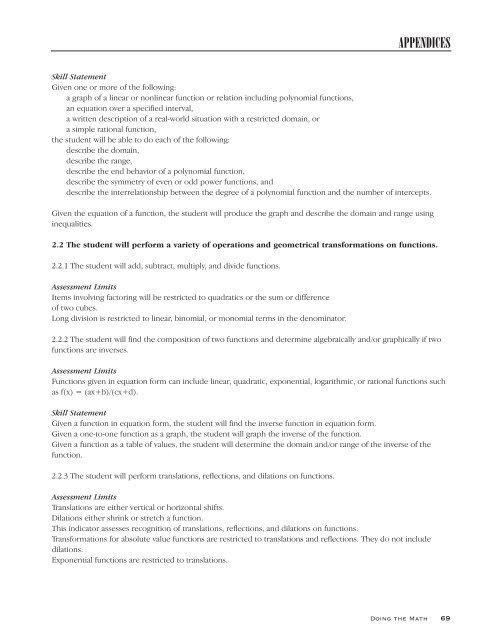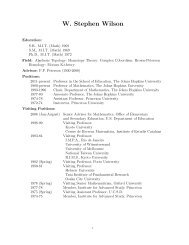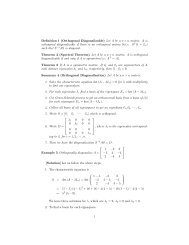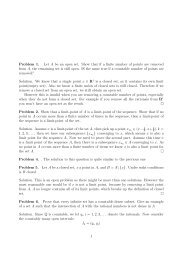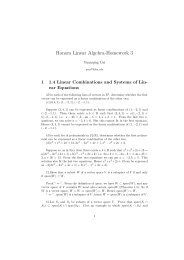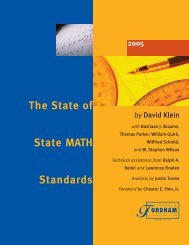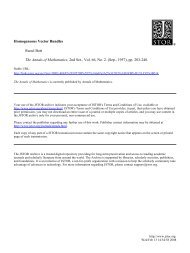Doing the Math - JHU Mathematics - Johns Hopkins University
Doing the Math - JHU Mathematics - Johns Hopkins University
Doing the Math - JHU Mathematics - Johns Hopkins University
You also want an ePaper? Increase the reach of your titles
YUMPU automatically turns print PDFs into web optimized ePapers that Google loves.
APPENDICES<br />
Skill Statement<br />
Given one or more of <strong>the</strong> following:<br />
a graph of a linear or nonlinear function or relation including polynomial functions,<br />
an equation over a specified interval,<br />
a written description of a real-world situation with a restricted domain, or<br />
a simple rational function,<br />
<strong>the</strong> student will be able to do each of <strong>the</strong> following:<br />
describe <strong>the</strong> domain,<br />
describe <strong>the</strong> range,<br />
describe <strong>the</strong> end behavior of a polynomial function,<br />
describe <strong>the</strong> symmetry of even or odd power functions, and<br />
describe <strong>the</strong> interrelationship between <strong>the</strong> degree of a polynomial function and <strong>the</strong> number of intercepts.<br />
Given <strong>the</strong> equation of a function, <strong>the</strong> student will produce <strong>the</strong> graph and describe <strong>the</strong> domain and range using<br />
inequalities.<br />
2.2 The student will perform a variety of operations and geometrical transformations on functions.<br />
2.2.1 The student will add, subtract, multiply, and divide functions.<br />
Assessment Limits<br />
Items involving factoring will be restricted to quadratics or <strong>the</strong> sum or difference<br />
of two cubes.<br />
Long division is restricted to linear, binomial, or monomial terms in <strong>the</strong> denominator.<br />
2.2.2 The student will find <strong>the</strong> composition of two functions and determine algebraically and/or graphically if two<br />
functions are inverses.<br />
Assessment Limits<br />
Functions given in equation form can include linear, quadratic, exponential, logarithmic, or rational functions such<br />
as f(x) = (ax+b)/(cx+d).<br />
Skill Statement<br />
Given a function in equation form, <strong>the</strong> student will find <strong>the</strong> inverse function in equation form.<br />
Given a one-to-one function as a graph, <strong>the</strong> student will graph <strong>the</strong> inverse of <strong>the</strong> function.<br />
Given a function as a table of values, <strong>the</strong> student will determine <strong>the</strong> domain and/or range of <strong>the</strong> inverse of <strong>the</strong><br />
function.<br />
2.2.3 The student will perform translations, reflections, and dilations on functions.<br />
Assessment Limits<br />
Translations are ei<strong>the</strong>r vertical or horizontal shifts.<br />
Dilations ei<strong>the</strong>r shrink or stretch a function.<br />
This indicator assesses recognition of translations, reflections, and dilations on functions.<br />
Transformations for absolute value functions are restricted to translations and reflections. They do not include<br />
dilations.<br />
Exponential functions are restricted to translations.<br />
<strong>Doing</strong> <strong>the</strong> <strong>Math</strong> 69


